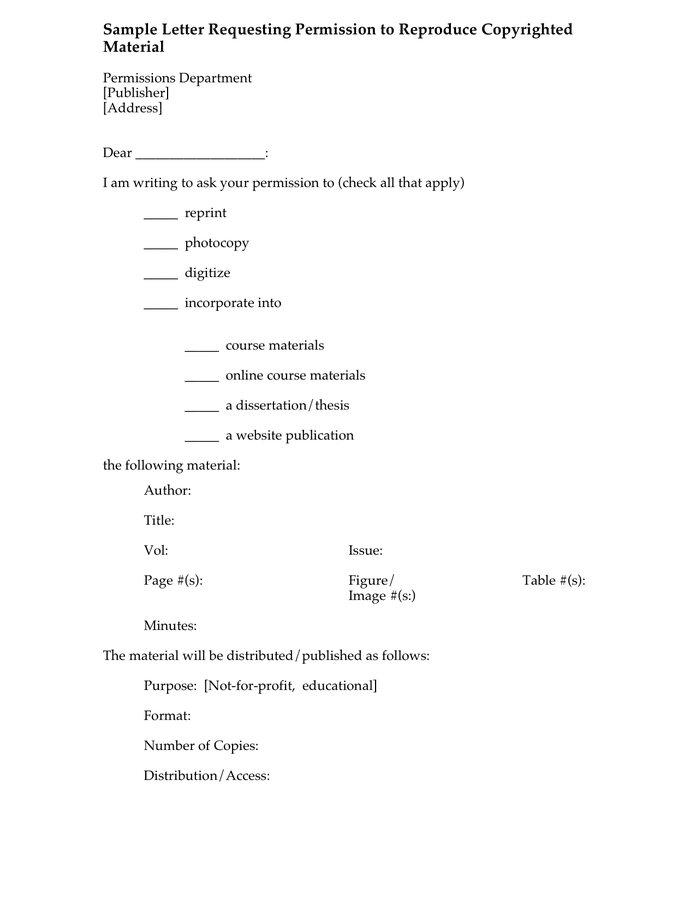
Legal Advice
· Paper, Typeface, Margins, Spacing, Oversized Materials, etc. Pagination; Figures and Illustrations; Electronic and Audiovisual Appendices; Using Copyrighted Material; Copyrighting Your Manuscript; Submission Checklists; Publishing Your Thesis or Dissertation; FAQ; Templates 2. The nature of the copyrighted work, such as whether the work is fiction or non-fiction, published or unpublished; 3. The amount of the work used in relation to the copyrighted work as a whole, such as using a poem in its entirety, or using one chapter from a long book; 4. The effect of the use upon the potential market for the copyrighted work · The author of a thesis or dissertation is fully responsible for the use of any copyrighted material in the manuscript. All quoted and paraphrased material must be properly cited. Generally, permission to use copyrighted material should be sought when a direct quotation of more than words or an illustration is used

Primary Nav Penn Provost
Your dissertation (and any other scholarly works you produce) is automatically copyrighted in your name as soon as it assumes a fixed form — i.e., as soon as it is written down. It remains under your full control until such a time that you sign a contract with someone else (e.g. a publisher) that gives them rights over your work. 2 · The author of a thesis or dissertation is fully responsible for the use of any copyrighted material in the manuscript. All quoted and paraphrased material must be properly cited. Generally, permission to use copyrighted material should be sought when a direct quotation of more than words or an illustration is used · In order to claim “fair use” of copyrighted material, the following factors must be weighed: (1) the purpose and character of the use, including whether such use is of a commercial nature or is for non-profit educational purposes; (2) the nature of the copyrighted work; (3) the amount and substantiality of the portion used in relation to the copyrighted work as a whole; Author: Samantha Hilton

Copyright Questions?
· Paper, Typeface, Margins, Spacing, Oversized Materials, etc. Pagination; Figures and Illustrations; Electronic and Audiovisual Appendices; Using Copyrighted Material; Copyrighting Your Manuscript; Submission Checklists; Publishing Your Thesis or Dissertation; FAQ; Templates 2. The nature of the copyrighted work, such as whether the work is fiction or non-fiction, published or unpublished; 3. The amount of the work used in relation to the copyrighted work as a whole, such as using a poem in its entirety, or using one chapter from a long book; 4. The effect of the use upon the potential market for the copyrighted work Dissertation Copyright Copyrighting your Dissertation. In the United States, you automatically own the copyright in your original creative Using Copyrighted or Previously Published Material in Your Dissertation. Previously published articles may be submitted Patent and Intellectual Property

Search form
Dissertation Copyright Copyrighting your Dissertation. In the United States, you automatically own the copyright in your original creative Using Copyrighted or Previously Published Material in Your Dissertation. Previously published articles may be submitted Patent and Intellectual Property · Paper, Typeface, Margins, Spacing, Oversized Materials, etc. Pagination; Figures and Illustrations; Electronic and Audiovisual Appendices; Using Copyrighted Material; Copyrighting Your Manuscript; Submission Checklists; Publishing Your Thesis or Dissertation; FAQ; Templates · If you use materials (such as text, images, sound recordings, etc.) created by a third party in your dissertation, you need to consider whether copyright law allows your use of those materials. In some cases, even reusing your own published articles can raise copyright concerns, if you have transferred your copyright to someone else, like your blogger.com: Raven Lanier

How to Acknowledge Use of Material by Other Authors
Your dissertation (and any other scholarly works you produce) is automatically copyrighted in your name as soon as it assumes a fixed form — i.e., as soon as it is written down. It remains under your full control until such a time that you sign a contract with someone else (e.g. a publisher) that gives them rights over your work. 2 Sample Request to Use Copyrighted Material Modified from Crews, Kenneth D. Copyright Law & Graduate Research: New Media, New Rights, and Your New Dissertation Instructions for Permission Letters Include your return address, telephone and fax numbers, and date. Confirm the exact name and address of the copyright holder 2. The nature of the copyrighted work, such as whether the work is fiction or non-fiction, published or unpublished; 3. The amount of the work used in relation to the copyrighted work as a whole, such as using a poem in its entirety, or using one chapter from a long book; 4. The effect of the use upon the potential market for the copyrighted work
No comments:
Post a Comment